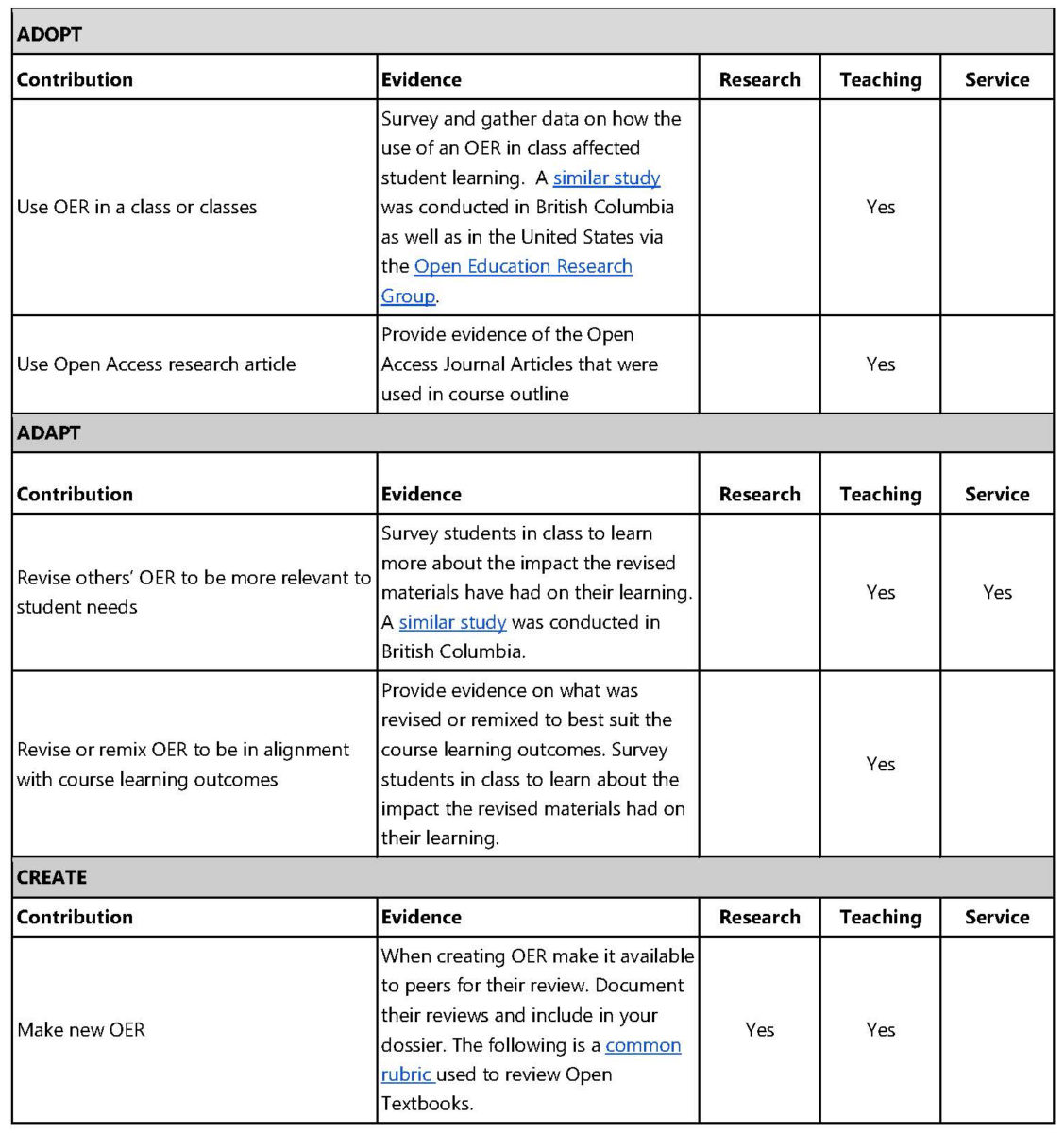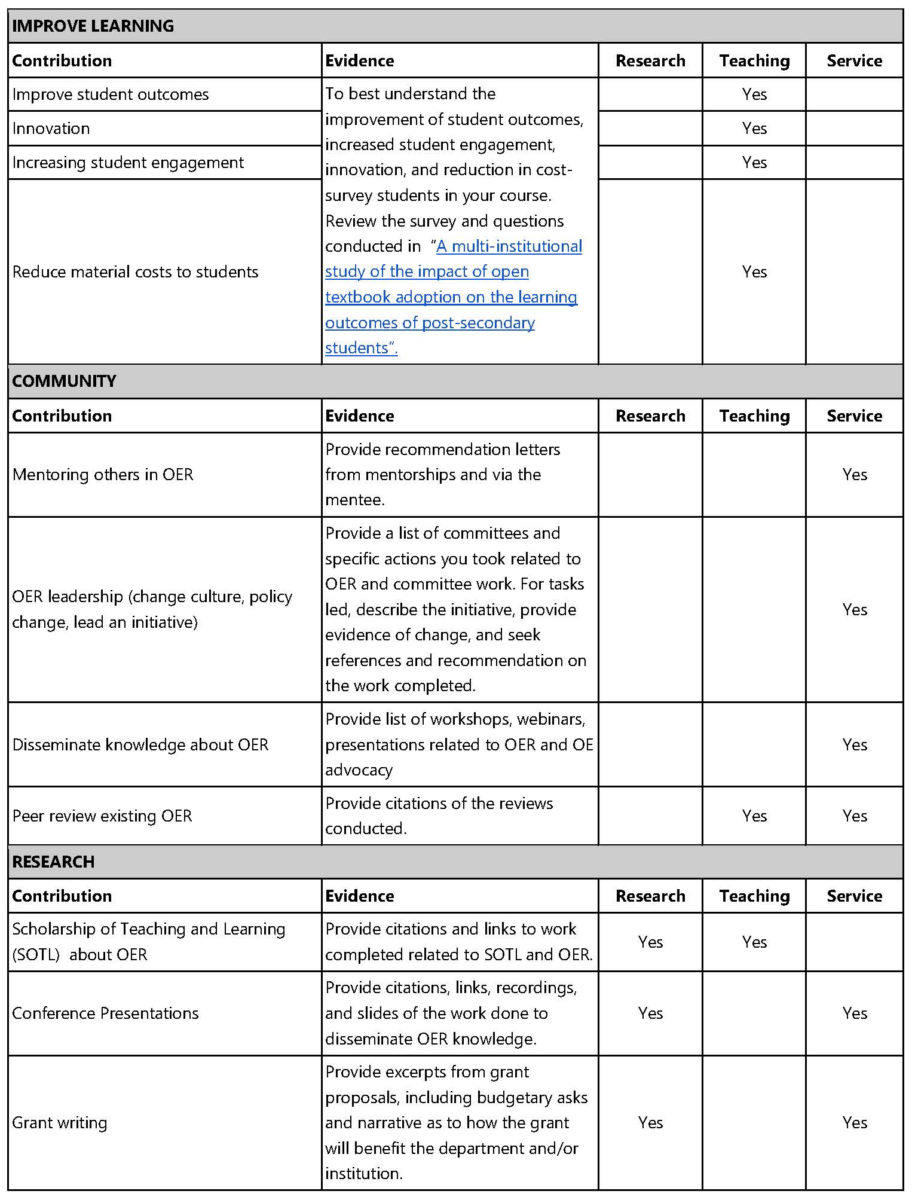 In the following Practitioner Perspective, Andrew McKinney, OER coordinator at the City University of New York (CUNY), and Amanda Coolidge, director of Open Education at BCcampus in British Columbia, Canada, share the development of an adaptable matrix to help faculty include OER (Open Educational Resources) in their tenure and promotion portfolios.
In the following Practitioner Perspective, Andrew McKinney, OER coordinator at the City University of New York (CUNY), and Amanda Coolidge, director of Open Education at BCcampus in British Columbia, Canada, share the development of an adaptable matrix to help faculty include OER (Open Educational Resources) in their tenure and promotion portfolios.
A critical part of sustaining OER in higher education is recognizing the contributions by instructors who create and improve OER as part of their professional work. Anyone familiar with the OER community knows that questions about the role of OER work in tenure, promotion and reappointment are constants at conferences and on listservs where OER practitioners and administrators congregate. However, as the criteria for tenure and promotion can vary wildly between different types of institutions and even between different departments within an institution, answering questions about the role of OER in the tenure and promotion process can seem daunting.
The Driving OER Sustainability for Student Success (DOERS3) collaborative recognizes this problem and has convened a group of OER professionals to brainstorm some possible solutions. This post examines the research we’ve done and the deliverable that came out of it, the OER Contributions Matrix. We argue that OER work, and Open Education more broadly, fit into the traditional tenure and promotion categories of research, teaching and service and that empowering faculty to frame their OER work in those categories can help change institutional culture.
DOERS3 is a collaborative of public higher education systems that run large-scale OER projects. The goal of DOERS3 is to help members build capacity to take established OER initiatives to scale and shape national and state innovation in OER research, data, policy, accessibility, equity and quality. What started in 2017 as a collaboration among the State University of New York (SUNY), the University System of Maryland (USM) and CUNY has expanded to include 18 different states and provinces across the U.S. and Canada and represents more than 6 million students at 650 colleges and universities. DOERS3 organizes its activities into three work groups: Equity, Research and Building Capacity. Each group works on projects that relate to the particular charge of the group and receive feedback from the DOERS3 steering committee and others around the OER community.
The work around tenure and promotion is spearheaded by the Building Capacity work group. The group includes representatives from CUNY, BCcampus, the Connecticut State University system, eCampus Ontario, the University of Texas system, SUNY and the California State University System. The general charge of the Building Capacity group is to address persistent issues that stand in the way of sustaining OER programs. So far, DOERS3 has embarked on two projects: the OER Contributions Matrix and a report on issues around listing and fulfillment of OER materials in college bookstores. Both projects attempt to address issues that our members have identified in their work as stumbling blocks on the way to scaling their own OER initiatives. We realize that both issues are persistent obstacles for many in the OER community. Putting our collective energies toward solving them stands to benefit the whole community. In the case of tenure and promotion, we knew it was very tricky and full of idiosyncrasies but also that addressing the problem could be invaluable.
Importance of tenure and promotion to OER
Tenure in the academy was first articulated in the 1940 Statement of Principles on Academic and Freedom and Tenure. The overall purpose of tenure is to ensure academic freedom and provide enough economic security to make the profession attractive. Open Education is a form of innovation that needs both academic freedom and economic security. And yet, only a handful of institutions across North America mention the work of Open Education in tenure and promotion guidelines.
One major challenge faced by OER and textbook affordability incentive programs is recruiting interested faculty and determining how to best support and reward the considerable work involved in adopting new course materials, according to 2020 work by Lily Todorinova and Zara T. Wilkinson of Rutgers University.
James Skidmore of the University of Waterloo recommended that institutions recognize the creation of OER in the tenure and promotion process. Doing so, he concluded, would communicate clearly that institutions of higher education take seriously the responsibility to tailor knowledge to students and to reduce barriers.
While two institutions in Canada—the University of British Columbia (UBC) and the Southern Alberta Institute of Technology—have explicitly mentioned Open Education in tenure and promotion policies, few have recognized open educational practices as deliverables toward tenure and promotion. The idea to include Open Education in UBC’s promotion and tenure guide came from trying to figure out how UBC could incentivize faculty to adopt open practices. Since faculty have many demands on their time and various important campus initiatives already competing for their attention, the student-led society sought ways to make open education stand out.
So why did we create a matrix?
DOERS3 has developed an adaptable matrix to help guide faculty as they attempt to include their OER work in their tenure and promotion portfolios.
We initially thought of soliciting the OER community for pre-existing tenure and promotion policies that included OER, so we might draft a model policy that the community could use at their own institutions. We set this aside partially because there were (and still are) so few pre-existing policies that would fit the bill, but also because we didn’t want to appear that we, a group of mostly administrators, were suggesting a top-down solution.
Due to the variance of the tenure and promotion process—and our desire to not be too prescriptive—we essentially ruled out a model policy or “Dear Colleague”-style letter for administrators and went back to the drawing board. What came to us was a more bottom-up approach. We wanted to help faculty and staff and administrators change the culture of their institutions. We felt that could be most effectively done by creating an adaptable matrix.
The matrix
We knew from our research that, while individual institutions or departments may differ from this matrix in its categories, most variations of tenure and promotion guidelines can be adapted to teaching, research and service. Therefore, we determined the best approach was to systematically think about how OER work—a varied class of work itself—might fit into those three categories (research, teaching and service), thus the development of the matrix.
For each contribution, we have suggested whether the contribution could apply to those three categories and, in some cases, have marked multiple categories; which one is most relevant will depend upon the context. In addition, the matrix includes examples of how faculty might think strategically about where their Open Education contributions would be valued most and how best to frame those contributions.
This matrix is in no way exhaustive but may be useful as either a way for faculty to start thinking about how to best fit their OER work into their local tenure and promotion guidelines. Faculty documenting their OER work in their portfolios should characterize their work using these terms to help their colleagues understand their contribution. Although this document in its current form was created with individual faculty in mind, we encourage tenure and promotion committees themselves to adapt and edit the document to use as guidance for their faculty. In true OER fashion, we have licensed the matrix as CC-BY. We hope that when faculty, staff or administrators adapt the matrix for their contexts that they share these adaptations back with the community.
The following matrix was provided by DOERS3. Click on each image for a larger view.

We are aware that even with examples, this is still a somewhat abstract document. Therefore, borrowing a method from software development, we offer some “user stories” or potential use cases of the matrix on a campus.
Faculty member. A faculty member who is heavily involved in the OER initiative on their campus is going up for tenure. The OER initiative on their campus has some support from the library and their Center for Teaching and Learning, but nominal support from the administration. The faculty member’s department hasn’t taken up OER in a systematic way and most of their fellow department members, especially those on the tenure and promotion committee, aren’t particularly aware of OER. This faculty member can use the matrix to help organize their OER work in their dossier and make the case for its inclusion to the tenure and promotion committee. They can also then share their experience with others in their OER initiative, helping future faculty members navigate the process. In an ideal scenario, the tenure and promotion committee in their department will be educated about OER and its value and will be more receptive to arguments in future cases. As more faculty members are able to use the matrix , they can start to adapt its categories and examples of OER work, making the matrix optimally useful for their institution.
Department chair. A department chair who has spearheaded an OER initiative in their department wants to make sure the faculty who have participated are given credit for their work and wants to incentivize OER creation in their department writ large. They adapt the matrix to show faculty how they can fit their OER work into their tenure and promotion dossier. This department chair could also share the matrix with other chairs on their campus who are interested in OER so they could adapt it for their own departments.
Librarian. An OER librarian is asked frequently by faculty that they work with how to talk about OER in their tenure and promotion dossiers. The librarian uses the matrix in their OER faculty development work and has faculty fill out the matrix with their own contributions and evidence. The librarian can then use those faculty adaptations as examples in their future faculty development work and can compile these adaptations to share with the broader OER community.
What’s next?
As we go about a “soft launch” of the matrix, sharing it with groups upon request (as in this article) we hope that faculty, staff and administrators who use it share it back to us and the community at large. Once there are use cases in the field, we would like to share these in a series of webinars to further broaden its use.
We think that the pathway to lasting and accepted policy change around tenure and promotion vis a vis OER needs to come from the bottom up. We like to think of this as practice determining policy, rather than policy determining practice. We hope that the OER Contributions Matrix can help empower faculty, staff and administrators to gain momentum in their efforts to make OER initiatives more sustainable and ingrained in the cultures of their institutions.
Related Posts:
Practitioner Perspectives: A Q&A on Steering Open Education in the Ocean State
5 Ways Open Educational Resources Can Help Students Succeed This Fall
Practitioner Perspectives: OER and a Call for Equity by Robin DeRosa
Practitioner Perspectives: Corcoran on NOLO—No-Cost & Low-Cost Course Designators
Practitioner Perspectives: A NEBHE Q&A with Thomas Edwards on Helping Students Save Money on Textbooks
Practitioner Perspectives: A NEBHE Q&A with Heather Miceli on How OER Promotes Hands-On Learning While Saving Students Money
What’s “Open” During COVID-19? In Global Pandemic, OER and Open Access Matter More than Ever
Massachusetts Is an OER Exemplar
[ssba]

